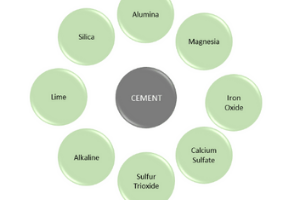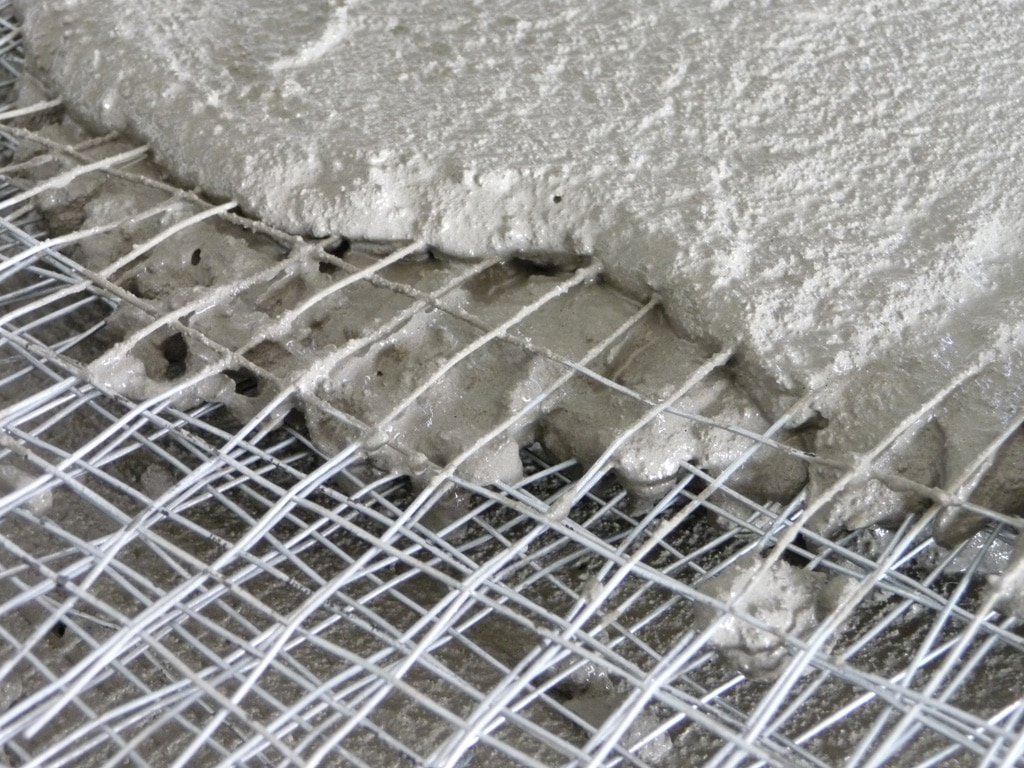Cement is a very important building material as a binding element. Almost all building work needs cement. Accordingly, the cement composition is of great interest to engineers. To grasp the structure of cement, one has to learn the quality of the ingredients of cement. By adjusting the quantity of an element during cement manufacturing, the desired value of cement can be achieved.

Ingredients of Cement
Table of Contents
Composition of Cement
There are 8 main cement ingredients. The following image is showing the ingredients of cement:

The general percentage of these ingredients in cement is given below:
| Ingredient | Percentage in cement |
|---|---|
| Lime | 60-65 |
| Silica | 17-25 |
| Alumina | 3-8 |
| Magnesia | 1-3 |
| Iron Oxide | 0.5-6 |
| Calcium Sulfate | 0.1-0.5 |
| Sulfur Trioxide | 1-3 |
| Alkaline | 0-1 |
Functions of Cement Ingredients
Different ingredients of cement and their proportions are as follows:
- Lime (CaO)
- Silica (SiO2)
- Alumina(Al2O3)
- Magnesia (MgO)
- Iron oxide (Fe2O3)
- Calcium sulfate (CaSO4)
- Sulfur Trioxide (SO3)
- Alkalis
1. Lime (CaO)
The most important ingredient in cement is lime and calcium oxide. There is 60 to 70 % lime in the concrete. This comes from calcareous, limestone, shale, etc. Adequate quantities of lime in cement are helpful in the production of calcium silicates and aluminates.

If lime is added in excess quantity, the cement becomes unsound as well as cement expansion and decomposition occurs. If lime content is lower than cement’s minimum requirement strength, it will decrease and also decrease cement setting time.
2. Silica (SiO2)

The second-largest amount of concrete materials is silica and silicon dioxide, which is about 17 to 25 %. You can get silica from water, argillaceous soil, and so on. Adequate amounts of silica help to shape di-calcium and tricalcium silicates that offer the cement energy.
Excess silica in concrete improves cement strength but also decreases the cement setting period at the same time.
3. Alumina (Al2O3)

In the form of aluminum oxide, alumina throughout cement is available. The alumina level of cement should be between 3 and 8 %. Bauxite is extracted, alumina produces cement, etc. Alumina provides the cement with a quick setting quality.
In particular, to achieve the desired value of cement, a high temperature is needed. But when added with cement ingredients, alumina acts as a flux and reduces the temperature of clinkering that ultimately weakens the cement. Therefore, alumina should not be used in excess quantity to maintain a high temperature.
4. Magnesia (MgO)

Concrete produces 1 to 3 % of magnesium oxide and magnesium oxide. Magnesia in small quantities of concrete gives the cement strength and color. If it reaches 3 %, the concrete becomes unsound and the cement’s intensity often reduces.
5. Iron oxide (Fe2O3)

The sum of iron oxide in cement varies from 0.5 to 6%. It can be extracted from fly ash, iron ore, scrap iron, and so on. The main function of iron oxide is to give the cement color. At high temperatures, by reacting with aluminum and calcium, iron oxide forms tricalcium aluminoferrite. The resulting product supplies the concrete with the characteristics of strength and toughness.
6. Calcium sulfate (CaSO4)

Calcium sulfate is found in the concrete in the form of gypsum. It’s packed along with calcareous. It ranges from 0.1%-0.5 %. The function of cement-based calcium sulfate is to increase the initial cement setting period.
7. Sulfur Trioxide(SO3)

Through steel, arsenic and sulfur trioxide is about 1 to 3%. Their role is to make the sound of concrete. The cement is unsound when it is in large volume.
8. Alkalis

The concrete includes alkalis such as soda and potash, which usually varies from 0% to 1%. At the moment of warming, most of the alkalis were carried away by the flue gases during the cement manufacturing process. Cement thus produces very small amounts of alkalis in it. Read More
If alkalis content is more than 1% then it will cause several problems like alkali-aggregate reaction, efflorescence, staining, etc.






